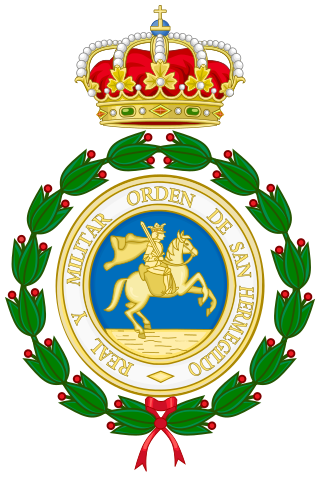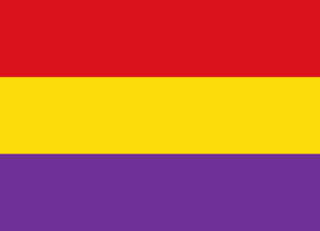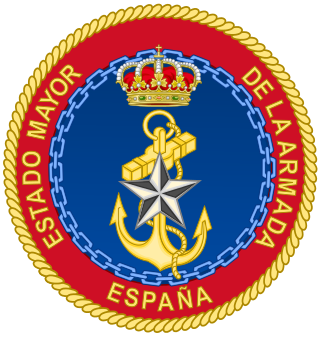
The Civil Guard is the oldest law enforcement agency in Spain and is one of two national police forces. As a national gendarmerie force, it is military in nature and is responsible for civil policing under the authority of both the Ministry of the Interior and the Ministry of Defence. The role of the Ministry of Defence is limited except in times of war when the Ministry has exclusive authority. The corps is colloquially known as the benemérita. In annual surveys, it generally ranks as the national institution most valued by Spaniards, closely followed by other law enforcement agencies and the armed forces.

The Marine Infantry is the naval infantry branch of the Spanish Navy responsible for conducting amphibious warfare. Fully integrated into the Spanish Navy's structure, the branch's history dates back to 1537 when Charles V, Holy Roman Emperor formed the Compañías Viejas del Mar de Nápoles, making it the oldest marine unit in existence.

The Royal and Military Order of Saint Hermenegild is both a general military honor and a legion created by King Ferdinand VII of Spain on 28 November 1814.

The Spanish Republican Army was the main branch of the Armed Forces of the Second Spanish Republic between 1931 and 1939.

José Olaguer Feliú y Ramírez was a Spanish lieutenant general, Minister of War and politician.

The 222nd Mixed Brigade, was a mixed brigade of the Spanish Republican Army in the Spanish Civil War. It was formed in the summer of 1937 with battalions of the Carabineros corps. Its only commander was the Carabineros Lieutenant Tiburcio Díaz Carrasco.

The 228th Mixed Brigade, was a short-lived mixed brigade of the Spanish Republican Army in the Spanish Civil War. It was formed in the last months of the Civil War with battalions belonging to the Carabineros corps. Its first and only leader was the Carabineros Commander Miguel Bascuñana Sánchez.

The 3rd Mixed Brigade, was one of the earliest mixed brigades of the Spanish Republican Army in the Spanish Civil War. It was formed in the fall of 1936 with battalions of the Carabineros corps and saw major action right away in the Defence of Madrid. This brigade also included female combatants —such as Sergeant "La Chata"— and would take part in most of the major battles of the Spanish Civil War, except in the Battle of Jarama.

The 109th Mixed Brigade, was a mixed brigade of the Spanish Republican Army in the Spanish Civil War. It was formed in the spring of 1937 in Utiel with four battalions, the 433, 434, 435 and 436.

The 182nd Mixed Brigade, was a mixed brigade of the Spanish Republican Army in the Spanish Civil War. It was formed in the spring of 1938 in Andalusia and had four battalions, the 725, 726, 727 and 728.

The Policía Armada, conventional long names Cuerpo de Policía Armada y de Tráfico and Fuerzas de Policía Armada, —popularly known as los grises owing to the color of their uniforms— was an armed urban police force of Spain established by the Francoist regime in 1939 to enforce the repression of all opposition to the regime. Its mission was "total and permanent vigilance, as well as repression when deemed necessary."

The Chief of Staff of the Navy or Admiral Chief of Staff of the Navy (AJEMA) is the highest-ranking military officer of the Spanish Navy that, under the authority of the Defence Minister, exercises command over the naval branch and, as such, is the principal military advisor to the Chief of the Defence Staff, the Minister of Defence, the Secretary of State for Defence, the Under-Secretary of Defence and the National Defence Council.

The 87th Mixed Brigade, was a mixed brigade of the Spanish Republican Army in the Spanish Civil War. It was formed in March 1937 with battalions of the Carabineros corps. Its first commander was Infantry Colonel Carlos Amores Cantos, who was succeeded by Militia Major Andrés Nieto Carmona.

The 8th Mixed Brigade was a mixed brigade of the Spanish Republican Army in the Spanish Civil War. It was formed at the beginning of the Defence of Madrid in early spring 1937 with battalions of the Carabineros corps and it remained in Madrid all along the war. Its first commander was Carabineros Lt. Colonel Enrique del Castillo Bravo who was succeeded by Carabineros Commanders Emeterio Jarillo Orgaz and José Casted Sena.

The second government of Francisco Franco was formed on 9 August 1939, following the end of the Spanish Civil War. It succeeded the first Franco government and was the Government of Spain from 9 August 1939 to 20 July 1945, a total of 2,172 days, or 5 years, 11 months and 11 days.
The 5th Division was one of the divisions of the People's Army of the Republic that were organized during the Spanish Civil War on the basis of the Mixed Brigades. It was deployed on the Madrid and Levante fronts.
The 71st Division was one of the divisions of the People's Army of the Republic that were organized during the Spanish Civil War on the basis of the Mixed Brigades. It came to operate on the Andalusian and Extremadura fronts.
The 67th Division was a unit of the Spanish Republican Army that existed during the Spanish Civil War, created on the basis of the mixed brigades. It came to be deployed on the fronts of Teruel, Extremadura and Levante.
The 192nd Mixed Brigade was a unit of the Spanish Republican Army created during the Spanish Civil War. Deployed on the Extremadura front, the unit played a minor role during the war.
Alfonso Pardo de Santayana y Coloma was a Spanish military officer who became General of the army and Chief of Staff of the Spanish Army (JEME).















